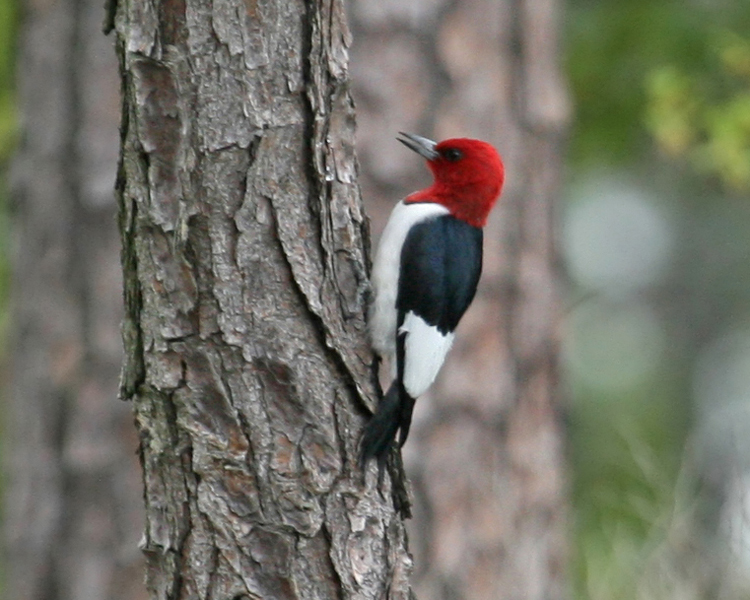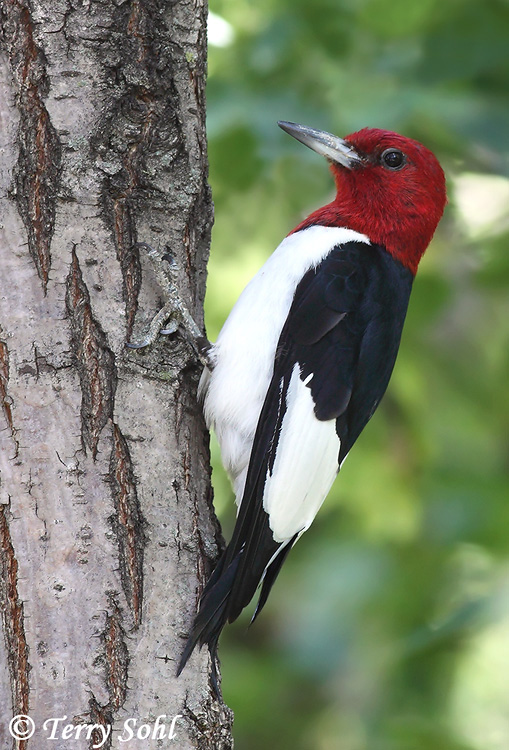
Melanerpes erythrocephalus
SUBFAMILY
Picinae
TAXONOMY
Picus erythrocephalus Linnaeus, 1758, based on Mark Catesby’s
drawing of the “Red-headed Wood-Pecker.”
OTHER COMMON NAMES
French: Pic а tкte rouge; German: Rotkopfspecht; Spanish:
Carpintero de Cabeza Roja.
PHYSICAL CHARACTERISTICS
9–10 in (24–26 cm); 2–3.4 oz (56–97 g). Adults have a completely
red head, black back and tail, white breast, black
wings with white secondaries that appear as a white shield
when the wings are folded over the back. Sexes are alike. Juveniles
have a gray-black head and some black markings on
white secondaries.
DISTRIBUTION
Breeds east of Rocky Mountains in North America from southern
regions of Saskatchewan, Manitoba, Ontario, and Quebec,
south to the Gulf of Mexico and south central Florida; winters
mostly in southern two-thirds of its breeding range, but farther
north during mild winters.
HABITAT
Open woodland, especially with oaks and beech; also roadsides
and open areas with scattered trees or utility poles. Often seasonally
moves from open areas in summer to bottomland forest
in fall and winter.
BEHAVIOR
Solitary or as pairs in summer, often found in loose social
groups in winter. Often very vocal in social groups. Interspecifically
territorial with red-bellied woodpeckers, but normally
more of an open-country bird than the red-bellied.
FEEDING ECOLOGY AND DIET
Often sallies from a perch to capture flying insects or to seize
arthropods and other small animals from the ground. It then
often takes its captured prey to the top of a stub or utility pole
that it regularly uses as a “chopping block” to remove legs and
other hard parts before eating. Takes considerable fruit,
acorns, beechnuts, and other nuts in season and will sometimes
cache these in cavities.
REPRODUCTIVE BIOLOGY
Poor cavity excavator and frequently uses old cavities or usurps
a fresh cavity from other species such as the red-bellied woodpecker.
When it excavates a cavity of its own, it is usually in a
well-rotted stub with a pre-existing crack that often forms a
flat side to the cavity entrance. Both pair members share cavity
excavation, incubation, and care of young. Nesting normally
occurs between April and August. Clutch size varies from 3 to
10 eggs, but is usually 4–5 eggs; incubation lasts 12–13 days;
young fledge at about 37–29 days. The red-headed woodpecker
often loses cavities to European starlings.
CONSERVATION STATUS
Not threatened, but suffers high mortality due to being hit by
vehicles when it comes to roads for insects; also suffers in competition
with European starlings.
SIGNIFICANCE TO HUMANS
Among the Chitimacha Indians of Louisiana, there is a folktale
about a great flood from which the red-headed woodpecker escaped
drowning by clinging to a cloud, but its tail hung down
into the dark water and to this day it has a black tail as a result.
The red feathers of red-headed woodpeckers have been
highly valued by Native Americans and used decoratively.
Other popular Animals
Photo Gallery of - Red-headed woodpecker




 Animalia Life
Animalia Life